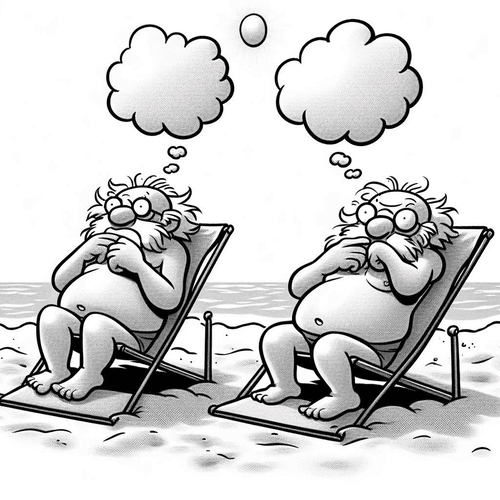Quantum Entanglement: The Hidden Code That Points to God’s Design
Albert Einstein once called it “spooky action at a distance,” a phenomenon so bizarre that he refused to accept it as real. Today, we know this mysterious quantum behaviour as entanglement—a feature of our universe that provides perhaps one of the most compelling scientific arguments for the existence of an intelligent Creator.
A previous post of ours (The God Equation: Quantum Physics and the Evidence for Design) revealed broad evidence for divine design. Today we dive deep into one of quantum physics’ most fascinating phenomena: quantum entanglement. Join us as we explore how it offers unique insights into God’s handiwork.
The Dance of the Entangled: Nature’s Mysterious Connection
When physicists first discovered quantum entanglement, they were struck by how it seemed to defy our fundamental understanding of reality.
Imagine two dancers performing a perfect duet while blindfolded and separated by an entire continent. No matter what movements one performer makes, the other instantly mirrors them with perfect precision. This analogy helps us grasp the extraordinary nature of quantum entanglement—a phenomenon where paired particles maintain an instantaneous connection regardless of distance.
Change the state of one particle, and its partner responds immediately, even if they’re on opposite sides of the universe. This isn’t merely a theoretical concept. Modern laboratories regularly create and manipulate entangled particles. It even forms the basis for emerging technologies—such as quantum computers and unbreakable encryption systems. The mathematics describing these interactions works with incredible precision, revealing an underlying order that challenges purely materialistic explanations of our universe.
The Divine Fingerprint in Quantum Mechanics
Consider for a moment what quantum entanglement reveals about the nature of our universe. We observe:
- Mathematical precision that random processes can’t explain
- Information transfer that appears to transcend space and time
- Fundamental particles that behave as if they’re part of a precisely orchestrated dance
These characteristics mirror what we would expect to find if our universe were designed by an infinite, all-knowing Creator. Just as complex computer codes requires skilled programmers, the mathematical precision of quantum mechanics points to a cosmic Programmer of unimaginable intelligence. And power.
Beyond Coincidence: The Problem for Naturalism
The naturalistic worldview faces significant challenges when attempting to explain quantum entanglement. How did such precise correlations arise by chance? The mathematics governing quantum interactions reveals a level of complexity and precision that defies random development.
Consider this: Even the slightest deviation in the laws governing quantum entanglement would make our universe uninhabitable. The precise values required for these interactions to work represent an extraordinarily fine-tuned system—one that aligns perfectly with the biblical description of a carefully crafted creation.
Information: The Divine Signature
Perhaps the most compelling argument for design comes from information theory. Quantum entanglement represents a form of information exchange that requires a sophisticated underlying framework. As Dr. John Lennox, Professor of Mathematics at Oxford University, often points out, information invariably points to an intelligent source.
The Bible anticipates this scientific discovery in numerous passages. Consider Colossians 1:17, which states that in Christ “all things hold together.” The quantum realm reveals a level of interconnectedness that ancient writers could never have known through natural observation, yet aligns perfectly with the Bible’s teaching.
Modern Science Confirms Ancient Truth
Recent experiments continue to reinforce the design argument. Scientists have discovered quantum coherence in biological systems, suggesting life itself depends on these precisely tuned quantum effects. The more we learn about quantum mechanics, the more we find evidence of sophisticated engineering at the most fundamental level of reality.
Leading researchers, even those without religious convictions, have expressed amazement at the orderly nature of quantum phenomena. Physicist Paul Davies notes, “The very fact that the universe is creative, and that the laws have permitted complex structures to emerge and develop to the point of consciousness is for me powerful evidence that there is ‘something going on’ behind it all.”
Practical Implications of Quantum Design
The design evident in quantum mechanics has practical applications that extend beyond theoretical physics:
- Quantum computing harnesses these precisely tuned laws to perform calculations impossible for classical computers
- Quantum cryptography uses entanglement to create unbreakable codes
- Quantum sensors exploit these effects for unprecedented precision in measurement
Each of these applications depends on the reliability and precision of quantum laws—a reliability that random chance can’t even begin to explain.
A Call to Deeper Understanding
Quantum entanglement challenges us to recognise the limitations of purely materialistic explanations for our universe. The precise mathematical relationships—the presence of complex information, and the fine-tuning required for these systems to function—all point to an intelligent Creator.
As we continue to uncover the mysteries of quantum mechanics, we find ourselves echoing the words of Psalm 19:1: “The heavens declare the glory of God; the skies proclaim the work of his hands.” Quantum entanglement, far from disproving God’s existence, provides compelling evidence for a universe crafted by an intelligent mind.
The more deeply we study the quantum realm, the more we discover the fingerprints of a Creator who transcends space and time—a Creator who has woven into the fabric of reality itself a testimony to His existence and wisdom.
Conclusion
Quantum entanglement Is a powerful reminder our universe operates according to precise, sophisticated laws that point to intelligent design. As we continue to unlock the mysteries of the quantum realm, we find ourselves not moving away from faith, but rather, discovering new reasons to marvel at the wisdom and power of our Creator.
For those seeking evidence of God’s existence in the natural world, quantum entanglement provides compelling scientific support for belief in a divine Creator. The hidden code of quantum mechanics reveals a universe that bears the unmistakable signature of intelligent design.
Quantum Entanglement Points to God’s Design: Related FAQs
Why don’t all quantum physicists see entanglement as evidence of design? Many physicists approach their work from a philosophical commitment to methodological naturalism, which requires seeking purely material explanations regardless of evidence suggesting design. The multiverse theory is often proposed as an alternative explanation, suggesting our precisely-tuned quantum laws exist by chance among infinite universes. However, it’s worth noting several prominent physicists, including Nobel laureates like Eugene Wigner and Brian Josephson, have acknowledged that quantum mechanics seems to point beyond purely materialistic explanations.
- How do we know entanglement isn’t just an illusion created by our measuring instruments? Scientists have conducted numerous “loophole-free” experiments that rule out instrumental errors or hidden variables as explanations for entanglement. The most rigorous tests, including those performed at Delft University in 2015, have conclusively demonstrated entangled particles really do influence each other instantaneously. These results have been replicated multiple times using different experimental setups and measurement techniques. They confirm entanglement is a fundamental feature of reality rather than an instrumental artefact.
How does the Copenhagen Interpretation of quantum mechanics compare to the design perspective? The mainstream Copenhagen Interpretation essentially asks us to accept quantum phenomena like entanglement as “just the way things are,” without seeking deeper explanation for why these precise mathematical relationships exist. While this approach has been pragmatically successful for doing physics, it deliberately avoids the deeper “why” questions that naturally arise. The design perspective offers a more complete explanation by accounting for both the mathematical precision and the source of the information inherent in quantum systems, while also explaining why these particular quantum laws—rather than any others—exist in forms that enable a life-supporting universe.
How do materialistic explanations fall short in explaining quantum entanglement? Purely materialistic explanations struggle to account for three key aspects of entanglement: the source of the precise mathematical relationships, the origin of quantum information, and the fine-tuning required for these effects to work in ways that enable rather than prevent life. Various materialistic theories such as decoherence and quantum Darwinism explain how entanglement operates but not why it exists with exactly the properties needed for a functional universe. The design hypothesis provides a more comprehensive explanation by accounting for both the mechanism and its origin in terms of purposeful engineering.
- Can new particles become naturally entangled, or must entanglement be artificially created? Particles can and do become naturally entangled through various physical interactions, including spontaneous particle decay and certain atomic processes. Natural entanglement occurs in biological systems, such as in photosynthesis and possibly in bird navigation, suggesting that God incorporated quantum effects into the design of life itself. This widespread presence of natural entanglement indicates it’s a fundamental feature of creation rather than merely a laboratory curiosity.
- Why is quantum entanglement maintained across vast distances but typically lost at room temperature? The fragility of quantum states at higher temperatures reflects the precise balance needed for a universe that can support both quantum effects and macroscopic life. The phenomenon known as decoherence, which causes entanglement to break down in warm environments, actually enables the stability of classical physics that we rely on for daily life. This delicate balance between quantum and classical behaviour suggests intentional fine-tuning in the laws of physics.
Why should we prefer the design explanation over competing theories like the many-worlds interpretation? The many-worlds interpretation, while mathematically elegant, multiplies entities beyond necessity by positing an infinite number of parallel universes to explain quantum phenomena. While it provides a mathematical framework, it raises more questions than it answers about the origin of the quantum laws themselves. The design hypothesis offers a more parsimonious explanation by pointing to a single intelligent source for both the mathematical precision and information content of quantum mechanics, while also explaining why these particular laws exist in forms that enable conscious observers to discover and understand them. Furthermore, the design perspective better accounts for the remarkable “unreasonable effectiveness of mathematics” in describing quantum phenomena, as Nobel laureate Eugene Wigner famously noted.
- What role do quantum fluctuations play in the design argument? Quantum fluctuations, often cited by naturalists as evidence of randomness in nature, actually demonstrate remarkably precise mathematical patterns that suggest design. These fluctuations occur within strictly defined probabilistic boundaries that maintain the stability of physical laws, showing a balance between flexibility and order that enables both atomic stability and biological processes. The fact that these apparently random fluctuations consistently produce results within the exact parameters needed for a life-supporting universe suggests they are more like carefully calibrated variations in a designed system than truly random events.
- How does the concept of information differ between quantum mechanics and classical physics? In classical physics, information behaves like a passive property that can be measured without being fundamentally altered, but quantum mechanics reveals information as an active, foundational aspect of reality that shapes physical behaviour. Quantum information exhibits unique properties like the inability to be perfectly copied (the no-cloning theorem) and the capacity to exist in multiple states simultaneously, suggesting a level of sophistication beyond what we would expect from purely material processes. These characteristics point to a universe that appears to be engineered with information as a fundamental building block, rather than information emerging as a by-product of physical processes.
Why is quantum mechanics considered counterintuitive, and how does this support the design argument? Quantum mechanics defies our everyday experience by exhibiting behaviours such as superposition, tunnelling, and entanglement that have no classical analogues. Yet these seemingly bizarre phenomena operate with mathematical precision and enable crucial processes in our universe. The fact that these counterintuitive quantum effects are precisely calibrated to enable essential processes—from photosynthesis to nuclear fusion in stars—suggests purposeful design rather than random emergence. This apparent discord between human intuition and quantum reality actually strengthens the design argument by demonstrating that quantum mechanics appears optimised for function rather than for human comprehension, exactly what we would expect if it were designed by a superior intelligence for practical purposes rather than emerging through natural processes that we evolved to understand.
Quantum Entanglement Points to God’s Design: Our Related Posts
- The God Equation: Quantum Physics and the Evidence for Design
- Does Math Reveal the Mind of God? The Divine Design in Numbers
- Patterns In Chaos: How Fractals Scream Intelligent Design
- The Mandelbrot Set: Surprising Evidence for Intelligent Design
- Sacred Symmetry: How Fibonacci Numbers Reveal God’s Design
Editor's Pick

Paul’s Mandate for Men: Headship Or Servant Leadership? Or Both?
Modern Christianity has fallen into a trap. We've created an either/or battle between "headship" and "servant leadership," as if these [...]

Should We Stop Using Male Pronouns for God? Why Do We Say No?
A friend of ours arrived eagerly at his first theology class in seminary. But he quickly discovered something troubling: the [...]

Did Old Testament Law Force Women to Marry their Rapists?
**Editor’s Note: This post is part of our series, ‘Satan’s Lies: Common Deceptions in the Church Today’… Viral misinformation abounds [...]

From Danvers To Nashville: Two Statements, One Biblical Vision
30 years separate the Danvers Statement on Biblical Manhood and Womanhood (1987) and the Nashville Statement on Human Sexuality (2017). [...]

The Nashville Statement: Why Affirm It Despite Media Backlash?
WHY DO REFORMED CHRISTIANS STAND BY THIS STATEMENT ON MARRIAGE AND GENDER? When the Nashville Statement was released in 2017, [...]

Who Is Belial? Solving The 2 Corinthians 6:15 Mystery
Belial: This name from the pages of Scripture chills the soul. Who is this mysterious figure Paul invokes in 2 [...]

Celibacy Or Castration: What Jesus Really Means in Matthew 19:12
One of Scripture's most shocking misinterpretations led theologian Origen to castrate himself in the third century. His tragic mistake? Taking [...]

Philippians 4:13: Did Paul Really Mean We Can Do ALL Things?
"I can do all things through Christ who strengthens me." It's on gym walls, graduation cards, and motivational posters everywhere. [...]

The Ordinary Means of Grace: Why Are They Indispensable?
ORDINARY MEANS FOR EXTRAORDINARY TRANSFORMATION What if God's most powerful work in believers' lives happens through the most ordinary activities? [...]

Is the Bible God’s Word? Or Does It Only Contain God’s Word?
The authority of Scripture stands at the crossroads of modern Christianity. While some argue the Bible merely contains God’s Word [...]
SUPPORT US:
Feel the Holy Spirit's gentle nudge to partner with us?
Donate Online:
Account Name: TRUTHS TO DIE FOR FOUNDATION
Account Number: 10243565459
Bank IFSC: IDFB0043391
Bank Name: IDFC FIRST BANK






